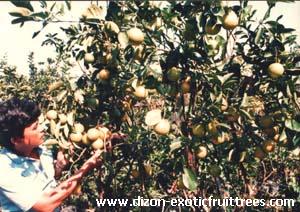|
|
| Agribusiness
Weekly, December 2 - 8, 1988 |
|
Buying (and
planting) high-quality citrus seedlings |
|
by Tony Rodriguez
|
|
|
The
popularity and good prices of citrus fruits, especially
during these months when colds and other rainy season
ailments of people are common, are encouraging
agribusinessmen to establish orchards.
A problem associated with this undertaking used to be
the insufficient supply of planting materials. But with the
mushrooming of fruit tree nurseries, especially in Batangas
and Laguna, the problem has metamorphosed. It has become a
problem of low quality planting materials and often,
diseased ones.
"The bulk of citrus planting materials that nursery
operators sell is budded seedlings," says
Bernie Dizon, who
runs the UP Bliss Economic Garden in Barangay San Vicente,
Diliman, Quezon City. "As long as they're disease-free,
usually because the Bureau of Plant Industry certifies that
the nursery is under its supervision, the seedling buyers
feel safe and go ahead with their plans to establish
orchards."
 The entrepreneurs will get the shock of their lives
five years later when the trees they planted die, as has
happened to a number of careless planters continues Dizon.
The seedlings that they planted were disease-free, yes, but
the way these were prepared in the nursery made them highly
susceptible to disease in the orchard later on. The entrepreneurs will get the shock of their lives
five years later when the trees they planted die, as has
happened to a number of careless planters continues Dizon.
The seedlings that they planted were disease-free, yes, but
the way these were prepared in the nursery made them highly
susceptible to disease in the orchard later on.
"A basic of the budded seedlings produced by most of
the nurseries is the low union point of rootstock and
scion," says Dizon, who has propagated plants for 20 years.
"This is especially true in calamansi and Mandarin varieties
(sintones or dalanghita) where the propagator use
calamandarin rootstock less than a year old and where the
bud union is low - about four inches from ground level -
making the seedling susceptible to foot rot. This disease is
the root cause of all the serious problems the the citrus
planter will encounter in his orchard when the trees are
fruiting."
According to Dizon, the most widely planted citrus
varieties in the country today are the Mandarin cultivars.
This is because these are more profitable to plant, easier
to manage and are more disease-resistant than most citrus if
they're not infected by foot rot, he says.
He recommends raising the budding point in the
rootstock stem to eight inches above the ground level. This
will ensure foot-rot-free stems as the susceptible portion -
the bud union - will be far from the soil. He also advices
the propagators to use older rootstock.
"An objection of nurserymen to a high budding point in
seedlings is that the rootstock portion of the planted tree
will be longer," says Dizon. "This portion will produce rain
shoots that if left uncut will be the dominant branches but
will not bear fruit because calamandarin is a poor bearer.
And even if the branches fruit, they'll produced sour, low
quality calamandarin and not the desired propagated citrus."
Dizon specializes in propagating sweet orange
varieties. He produces budded seedlings of Hamlin, Navel,
Pineapple, Queen, Valencia and Satsuma orange.
He cautions prospective planters who buy what they
think are Valencia seedlings when in fact they are
grapefruit and not sweet orange. Grapefruit, he says, is
related to pummelo. Often, the nursery operators honestly
think they're propagating Valencia.
"A sweet orange that I recommend to planters is the
Satsuma," says Dizon. It's the only variety, as far as I've
seen, that's completely resistant to foot rot disease."
He also recommends pummelo. the varieties of this
citrus that he has seedlings of are the Davao Pink, The Amoy
that bears big - four kilogram - fruit, the local Songsong,
and two varieties from Thailand.
"Planters who want trees that will bear fruit for a
long time should plant pummelo," says Dizon. "For my
seedlings, I use native pummelo rootstock that I buy from
Cagayan Valley. This native cultivar is hardy and drought
and disease-resistant."
To add to the trees' resistance to water stress, Dizon
applies his double or triple-rootstock technique in planting
pummelo and sweet orange. When planting the budded seedling,
he plants a second or third rootstock at a much deeper level
than the propagated variety and inarches or grafts these to
the budded seedling. The deeply planted rootstocks will
support the tree through severe drought, cause it to bear
more and better quality fruit because it can get more
nutrients from the soil, and also it withstand typhoon wind
even ion mountainous places.
Dizon started applying this planting method in 1987
when an American visitor who had seen orange plantations in
Florida in the US asked him why it was not being done in the
Philippines. Now he does it in the orchards that he is
helping establish in southern and central Luzon.
"I'm willing to teach the technique to everyone
interested free of charge," says Dizon, who is committed to
do his part in the advancement of a local fruit industry.
"It's easy to learn and apply, and it's profitable for
orchard owners." |
|
|

